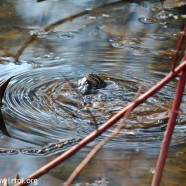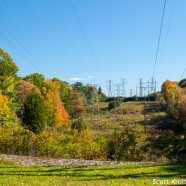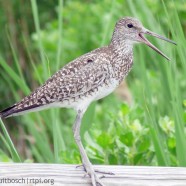Male Competition
The Wood Frog (Rana sylvatica) is another early spring breeding amphibian common to our region. These explosive breeders utilize vernal pools, just like spotted salamanders, and their breeding activities are squeezed into just a few days. As the frogs enter the pools, males will take up their positions floating at the surface of the pool croaking their characteristic call. While they are calling, they will often joust with one another, especially if a female is nearby. These two males had a bit of a tousle, but both went on to call in another spot ready for females to come their way. Elyse...
Read MoreDiurnal Barred Owl
Recently I heard a Barred Owl calling during the mid-afternoon on a warm, beautiful day. It did not take but a few minutes for an even closer bird to start asking, “Who cooks for you?” in response. They were relatively close to me but out of sight in neighboring yards. This photo is from a past sighting of a diurnal Barred Owl during the early spring when the leaves were already popping. Keep an ear open for these nocturnal neighbors all day and night! Scott Kruitbosch Conservation & Outreach Coordinator
Read MoreEurasian Wigeon Calling & Courting
Take a look and listen to this drake Eurasian Wigeon calling and courting some female American Wigeons, off camera. His loud call is one you are not likely to hear over here in North America! This bird is a continuing individual that has spent months in Stratford, Connecticut. Spring waterfowl activity is building up, and I wonder if this guy will actually spend breeding season here. Scott Kruitbosch Conservation & Outreach...
Read MorePowerline corridors, plants and wildlife
Powerline corridors, as well as gas and oil pipeline right of ways, are often an unexpected habitat oasis. They cover millions of acres of land in America. They may also provide a tremendous benefit to plants and wildlife that favor scrub or early successional habitat, a type that we do not favor in our development otherwise. Certain bees and butterflies to flowers and birds can all end up winning if these strips are managed properly – limiting mowing, chemicals, invasive plants and so forth. As humans have worked to protect forests we have neglected to do the same for this habitat...
Read MoreWillet (Tringa semipalmata)
This Willet (Tringa semipalmata) had a lot to say…and I left as quickly as I could!
Read More








